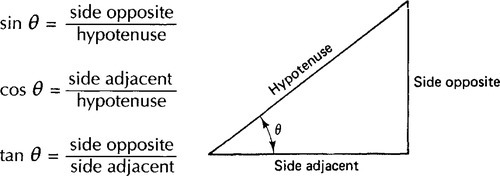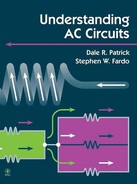Trigonometry for AC Electronics
Trigonometry is a valuable mathematical tool for anyone who studies ac electronics. Trigonometry deals with angles and triangles, particularly the right triangle, which has one angle of 90°. An example of an electronics right triangle is shown in Fig. B-1. This example illustrates how resistance, reactance, and impedance are related in ac circuits. We know that resistance (R.) and reactance (X) are 90° apart, so their angle of intersection forms a right angle. We can use the law of right triangles, known as the Pythagorean theorem, to solve for the value of any side. This theorem states that in any right triangle, the square of the hypotenuse is equal to the sum of the squares of the other two sides. We can express the Pythagorean theorem mathematically as follows:
![]()
Or
![]()

By using trigonometrie relations, we can solve problems dealing with phase angles, power factor, and reactive power in ac circuits. The three most used trigonometric functions are the sine, the cosine, and the tangent. Fig. B-2 illustrates how these functions are expressed mathematically. Their values can be found with a scientific calculator.

This process can be reversed to find the size of an angle when the ratios of the sides are known. The term inverse function is used to indicate this process. For example, the notation inv sin X = θ means that θ is the angle the sine of which is x. To solve inv sin 0.9455 = θ, look through the column of sine functions in Table B-1 and find that angle θ is 71° These functions are easily solved with a calculator.
Trigonometric ratios hold true for angles of any size; however, angles in the first quadrant of a standard graph (0° to 90°) are used as a reference. To solve for angles greater than 90° (second-, third-, and fourth-quadrant angles), they must first be expressed as equivalent first-quadrant angles (Fig. B-3). All first-quadrant angles have positive functions, whereas angles in the second, third, and fourth quadrants have two negative functions and one positive function.

